How Long Does Vacuum Sealed Food Last
Vacuum-sealed food's longevity depends on what you're storing and where you keep it. In your freezer, vacuum-sealed meats can last 2-3 years, while refrigerated meats stay fresh for 1-2 weeks. You'll get 4-6 weeks from hard cheeses and 2-3 weeks from fresh vegetables when properly sealed and refrigerated. Dry goods like rice, beans, and pasta can maintain quality for up to five years in your pantry when vacuum-sealed and stored at the right temperature. Your success with vacuum sealing relies on proper technique, clean equipment, and consistent storage temperatures. Understanding the specific requirements for different food types will help maximize your preservation efforts.
This post may contain affiliate links. If you make a purchase through these links, I may earn a commission at no additional cost to you. Additionally, portions of this post may be generated using artificial intelligence (AI) technology. While we strive for accuracy, please be aware that AI-generated content may not always be perfect and should be fact-checked when necessary.
The Spatula Scoops
- Frozen vacuum-sealed meats last 2-3 years, while refrigerated vacuum-sealed fresh meats remain good for 1-2 weeks.
- Vacuum-sealed dry goods like rice, beans, and pasta can stay fresh for up to 5 years when stored properly.
- Fresh vegetables last 2-3 weeks when vacuum-sealed and refrigerated, while hard vegetables extend to 3-4 weeks.
- Hard cheeses maintain quality for 4-6 weeks, while deli meats and prepared salads last 7-10 days when vacuum-sealed.
- Coffee beans and nuts stay fresh for up to 3 years, while dried fruits and cereals last 12-18 months when vacuum-sealed.
Understanding Vacuum Sealing Basics
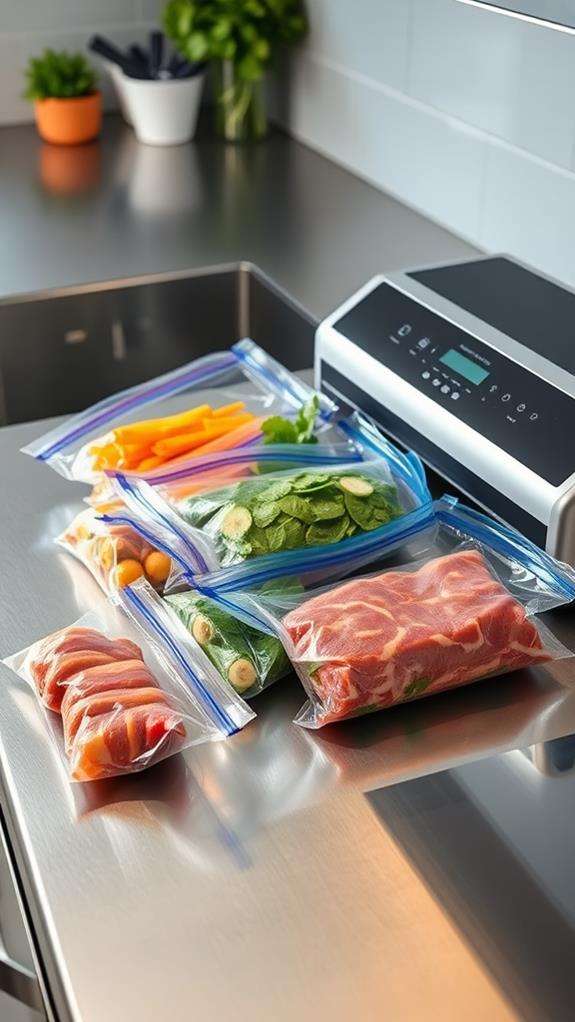
Nearly all food preservation methods pale in comparison to vacuum sealing when it comes to extending shelf life. This powerful preservation technique removes air from storage containers or bags, creating an environment where bacteria and other spoilage organisms can't thrive.
You'll find that vacuum sealing works through a straightforward process: the sealer removes oxygen from the package while creating an airtight seal around your food. The removal of air helps prevent oxidation, which is responsible for many forms of food deterioration, including freezer burn, rancidity, and mold growth.
When you're vacuum sealing foods, you'll need to understand two key components: the barrier material and the seal integrity. The barrier material, typically a multi-layer plastic designed for food storage, prevents oxygen and moisture from penetrating the package. The seal integrity depends on both the quality of your sealer and proper technique – any wrinkles or food particles in the seal area can compromise its effectiveness. You'll also want to take into account the food's moisture content, as excess liquid can interfere with creating a proper seal and potentially damage your vacuum sealer's pump system.
Storage Temperature Guidelines
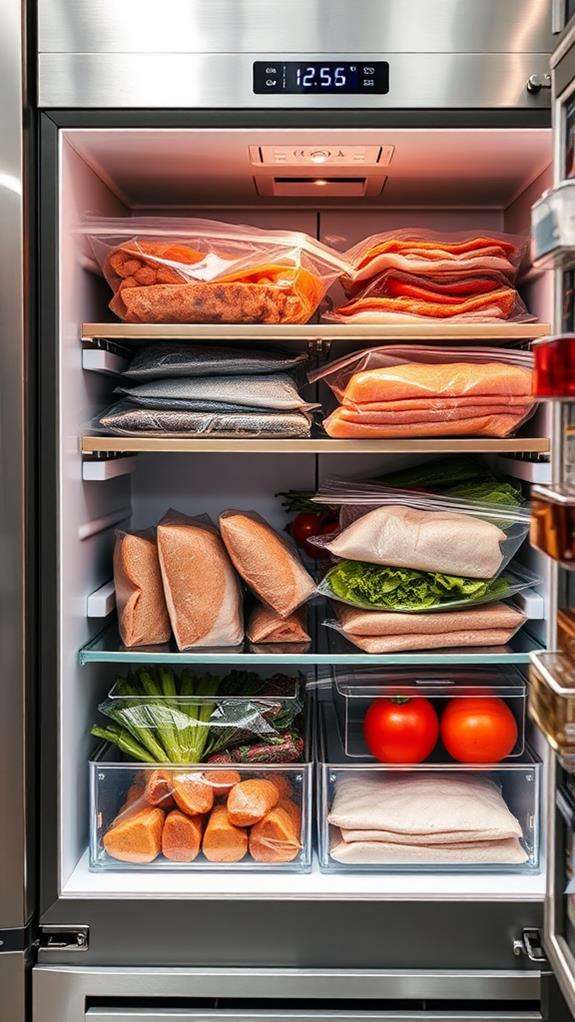
Proper storage temperature plays an essential role in maximizing the shelf life of vacuum-sealed foods. You'll need to store different types of foods at specific temperatures to guarantee they remain fresh and safe for consumption.
For your pantry items, like rice, dried beans, and nuts, you can store them at room temperature (around 50-70°F), but you'll want to keep them away from direct sunlight and heat sources. When it comes to refrigerated items, maintain a consistent temperature between 34-40°F for best preservation. You'll find that meats, cheese, and prepared foods will last notably longer at these temperatures.
For long-term storage, your freezer should be set at 0°F or below. At this temperature, you can store vacuum-sealed meats for up to 2-3 years, vegetables for 2-3 years, and fish for 1-2 years. Remember that temperature fluctuations can greatly impact food quality, so you'll want to avoid opening and closing your freezer frequently. If you're storing items in a deep freezer, you'll get even better results since these units maintain more consistent temperatures than standard freezer compartments.
Refrigerated Vacuum Sealed Foods
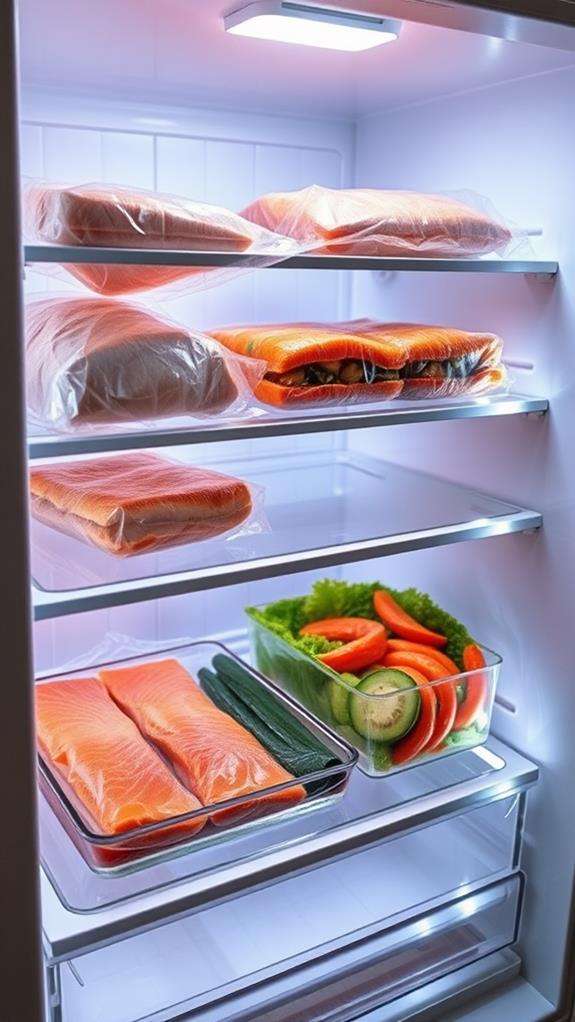
When storing vacuum sealed foods in your refrigerator, you'll want to maintain a consistent temperature between 34-40°F (1-4°C) to maximize preservation and prevent bacterial growth. Common refrigerated items that benefit from vacuum sealing include deli meats, hard cheeses, smoked fish, fresh pasta, and pre-cooked meals, which can extend their shelf life notably compared to conventional storage methods. While regular refrigerated foods might last 1-3 days, your vacuum sealed counterparts can remain fresh for 1-2 weeks (soft cheeses, fresh meats) up to 4-6 weeks (hard cheeses, cured meats), depending on the specific food type and initial freshness.
Storage Temperature Best Practices
Temperature control serves as the foundation for storing vacuum sealed foods in your refrigerator. You'll want to maintain a consistent temperature between 34°F and 40°F (1°C to 4°C) to maximize shelf life and prevent bacterial growth. The colder section of this range, around 34°F to 36°F, is ideal for most vacuum sealed meats and seafood.
When storing different types of vacuum sealed foods, you should organize them strategically within your refrigerator. Place raw meats on the bottom shelf to prevent cross-contamination from potential drips, and keep produce in the crisper drawers where humidity levels are optimized. You'll find that the door compartments, which experience the most temperature fluctuation, aren't suitable for vacuum sealed items.
It's crucial to monitor your refrigerator's temperature using a reliable thermometer, as built-in gauges aren't always accurate. If you're storing vacuum sealed foods long-term, you'll want to check the temperature at least weekly. Remember that opening and closing your refrigerator door frequently can cause temperature fluctuations, so you should minimize this activity and confirm the door seals properly after each use.
Common Refrigerated Food Types
Various vacuum sealed foods maintain different shelf lives in your refrigerator, with fresh meats and seafood typically lasting 1-2 weeks, while hard cheeses can stay fresh for 4-6 weeks. You'll find that raw poultry remains safe for 10-14 days, whereas beef, pork, and lamb cuts can last up to 14 days when properly vacuum sealed and refrigerated at 40°F or below.
Fresh vegetables, when vacuum sealed, typically maintain their quality for 2-3 weeks in your refrigerator, though leafy greens tend to last only 7-10 days. Dairy products like soft cheeses have a refrigerated shelf life of 2-3 weeks, while yogurt and sour cream can stay fresh for up to 3 weeks. You'll notice that deli meats and prepared salads last 7-10 days when vacuum sealed, doubling their typical storage time.
For ideal freshness, you should store vacuum sealed fruits for no more than 2 weeks, as their natural ripening process continues even under seal. Cooked meats and prepared dishes generally maintain their quality for 10-14 days, though you'll want to check for any signs of spoilage before consuming them.
Expected Shelf Life Ranges
Refrigerated vacuum sealed foods typically follow predictable shelf life patterns, with most items lasting 1-4 weeks when stored at ideal temperatures. You'll find that different food categories have varying longevity, which depends largely on their moisture content, acidity levels, and initial freshness before sealing.
| Food Category | Standard Shelf Life | Vacuum Sealed Life |
|---|---|---|
| Raw Meat | 1-2 days | 2-3 weeks |
| Hard Cheese | 1-2 weeks | 4-8 weeks |
| Fresh Vegetables | 3-5 days | 2-3 weeks |
When you're storing vacuum sealed foods in your refrigerator, you'll need to maintain temperatures between 34-40°F (1-4°C) for best preservation. You can extend these timeframes by following proper sealing techniques, including removing all air pockets and ensuring a complete seal. Remember that while vacuum sealing greatly extends shelf life, it doesn't indefinitely prevent spoilage. You should always check for signs of deterioration before consumption, such as unusual odors, discoloration, or texture changes. If you're dealing with high-moisture foods like fresh fruits, you'll notice they typically have shorter storage times even when vacuum sealed, due to their water content affecting bacterial growth rates.
Frozen Vacuum Sealed Meats
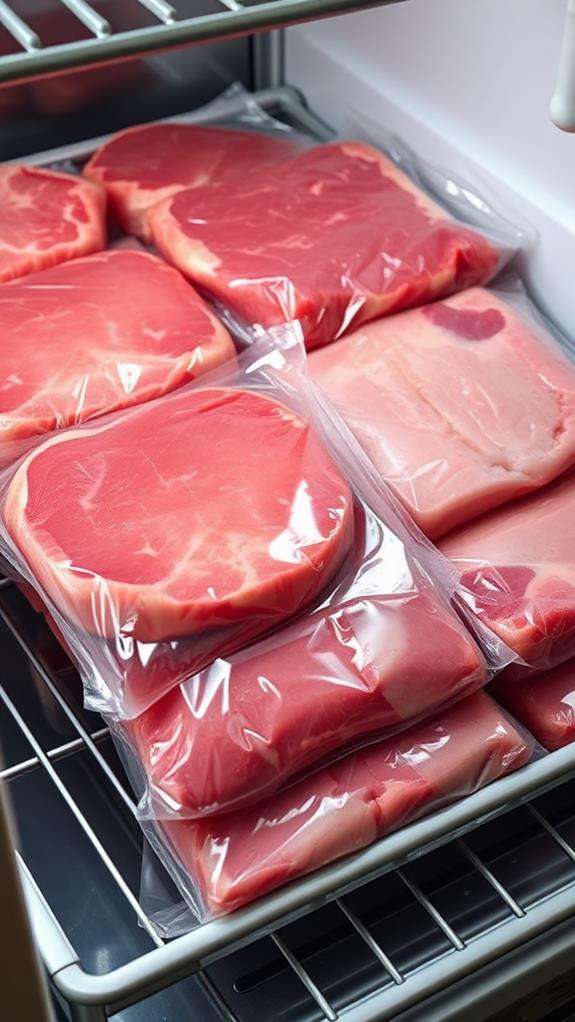
When properly vacuum sealed and stored in your freezer at 0°F (-18°C), meats can last markedly longer than their conventional freezer storage counterparts. You'll find that vacuum-sealed beef and lamb can maintain quality for up to 2-3 years, while pork and poultry typically last 1-2 years in ideal conditions.
To achieve these extended storage times, you'll need to verify your vacuum sealer creates an airtight barrier, preventing freezer burn and oxidation. The key is removing as much air as possible before sealing, as any trapped oxygen can lead to quality deterioration. When packaging your meats, you should portion them into serving sizes you'll actually use, as repeated thawing and refreezing can compromise both safety and quality.
For best results, you'll want to label each package with the date of freezing and contents. While these meats can last several years, you'll notice peak flavor and texture when consumed within the first year. Remember that the freezer temperature must remain constant, as fluctuations can lead to ice crystal formation and impact the meat's cellular structure, affecting its overall quality upon thawing.
Dry Goods Storage Duration
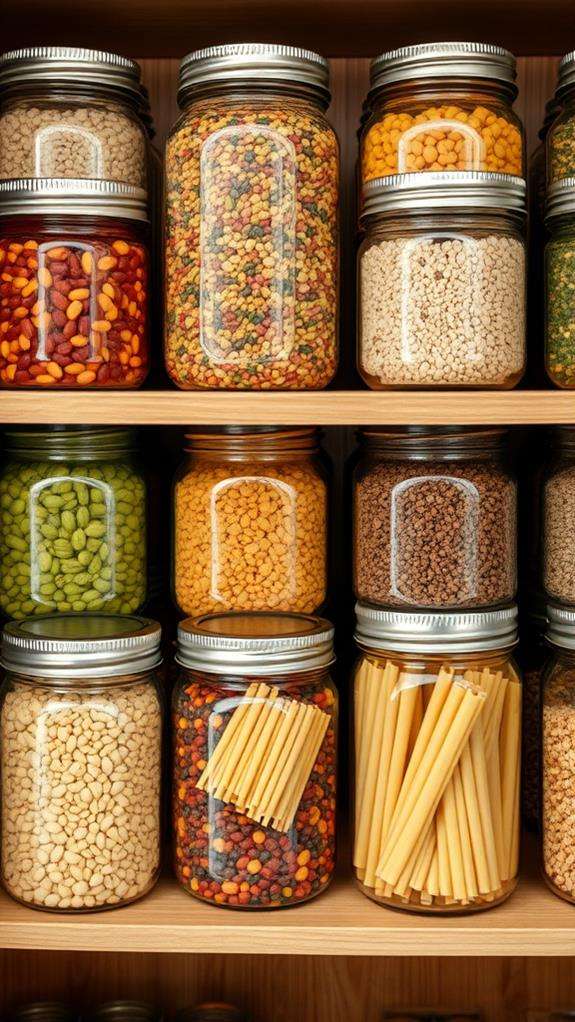
Moving from frozen storage to pantry items, dry goods offer some of the most impressive shelf life extensions when vacuum sealed. You'll find that basic staples like rice, beans, and pasta can last up to five years when properly sealed, compared to just six months to a year in their original packaging. Even items like coffee beans and nuts, which typically go stale quickly, can maintain their freshness for up to three years.
For your dried fruits and cereals, you can expect preservation times of 12-18 months when vacuum sealed, while they'd normally last only 4-6 months in standard containers. Sugar, salt, and other non-perishable ingredients will stay pristine indefinitely, though you'll still want to store them in a cool, dark place. You'll need to pay special attention to powdered items like flour or powdered milk – they require a filter or pre-sealed container inside the vacuum bag to prevent the powder from being sucked into your sealer's mechanism. When storing crackers, chips, or other delicate dry goods, you'll want to use the pulse function on your vacuum sealer to prevent crushing, and they'll reward you with up to six months of crispy freshness.
Fruits and Vegetables Shelf Life
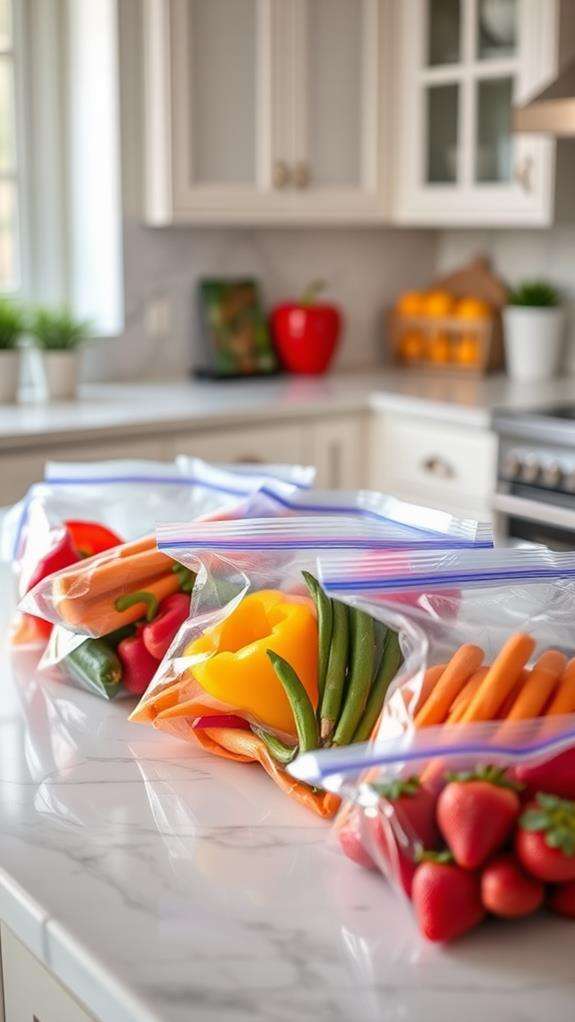
Fresh fruits and vegetables present unique challenges in vacuum sealing due to their high moisture content and delicate nature. You'll need to properly prepare your produce before sealing to guarantee the best results and longest possible shelf life.
When you've vacuum sealed your fruits and vegetables correctly, you can expect most fresh produce to last 2-3 weeks in the refrigerator, compared to their typical 1-week storage life. Hard vegetables like carrots and celery can maintain their quality for 3-4 weeks, while softer items like berries and leafy greens might last 1-2 weeks. If you're freezing your vacuum-sealed produce, you'll see considerably longer storage times of 2-3 years, though texture changes may occur.
To maximize shelf life, you'll want to blanch vegetables before sealing, which helps maintain color and nutrients. For fruits, consider flash-freezing before vacuum sealing to prevent crushing. You can also use oxygen absorbers in conjunction with vacuum sealing for ideal results. Remember to pre-freeze soft fruits and vegetables to prevent them from being crushed during the vacuum process, and always make sure they're completely dry before sealing.
Signs of Food Spoilage

Despite vacuum sealing's effectiveness at preserving food, you'll need to watch for key signs that indicate spoilage has occurred. The most obvious indicator is any visible mold growth, which can appear as white, green, or black spots on your stored items. If you notice unusual bulging in the vacuum-sealed package, it's likely that bacteria have produced gases, making the food unsafe to consume.
Your senses are essential tools for detecting spoilage. When you open the package, pay attention to any off-putting or sour odors, which often signal bacterial growth. The texture of spoiled food will typically change – meat might become slimy, vegetables could turn mushy, and fruits may develop a mealy consistency. You'll want to check for any discoloration, particularly with meats that may turn grayish or greenish instead of their natural color.
If you're storing clear liquids, watch for cloudiness or separation that wasn't present during packaging. Remember that even if the vacuum seal remains intact, factors like temperature fluctuations and initial contamination can lead to spoilage. When in doubt about your vacuum-sealed food's safety, it's always better to discard it rather than risk foodborne illness.
Best Vacuum Sealing Practices
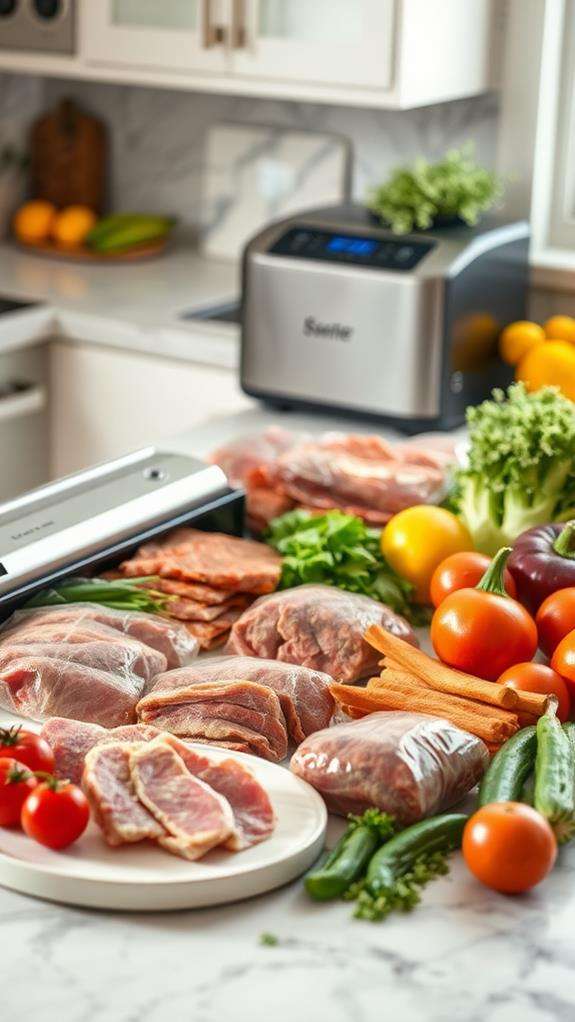
To maximize the shelf life of your vacuum-sealed foods, you'll need to start with impeccably clean equipment, wiping down all surfaces with food-safe sanitizer and ensuring your sealing machine is free from any debris or residue. When selecting bags, choose high-quality options specifically designed for vacuum sealing, with appropriate thickness and material composition for your specific food type (thicker for sharp items like bones, standard for softer foods). Before sealing, carefully arrange food items to prevent air pockets from forming, and if you're sealing multiple items, leave adequate space between them to create strong, reliable seals.
Clean Equipment Before Use
Keeping your vacuum sealer spotless isn't just about appearances – it's crucial for food safety and peak performance. Before each use, you'll need to thoroughly clean and sanitize your equipment to prevent cross-contamination and guarantee ideal sealing conditions.
Here's what you'll need to do before using your vacuum sealer:
- Wipe down all surfaces with a food-grade sanitizing solution, paying special attention to the sealing strip and vacuum chamber where food particles often accumulate
- Inspect the rubber gaskets and sealing elements for any residue or damage, as these components directly impact the quality of your vacuum seal
- Clean the drip tray thoroughly if your model has one, as trapped liquids can compromise the vacuum process and lead to bacterial growth
- Check and clean the filter screen to prevent debris from entering the vacuum pump, which could cause mechanical issues over time
Once you've completed these cleaning steps, dry all components completely with a lint-free cloth. Moisture can interfere with the sealing process and potentially damage your machine's electrical components. Remember to maintain a cleaning log if you're using your sealer in a commercial kitchen or food processing environment.
Proper Bag Selection Tips
Selecting the right vacuum sealer bags stands as one of the most essential factors for successful food preservation. You'll need to evaluate several key characteristics when choosing your bags to guarantee ideal food storage and longevity.
| Bag Type | Best Uses | Storage Duration |
|---|---|---|
| Channel Bags | Dry goods, sharp items | 1-2 years |
| Mesh Bags | Delicate produce, herbs | 6-12 months |
| Heavy-duty Bags | Meats, seafood | 2-3 years |
| Textured Bags | Moist foods, marinades | 1-2 years |
When selecting your bags, you'll want to match the thickness to your intended use. For example, if you're storing items with sharp edges like bones or pasta, opt for bags that are at least 4 millimeters thick. The bag's width matters too – you'll need about 2 inches of extra space on each side for proper sealing.
Don't forget to check the bag's temperature tolerance if you plan to sous vide or microwave your food later. Most quality bags can withstand temperatures from -40°F to 180°F, but you'll need specialized bags for higher temperatures. Always verify that your chosen bags are BPA-free and FDA-approved for food storage.
Avoid Air Pocket Formation
During the vacuum sealing process, air pockets can greatly reduce your food's shelf life and compromise its quality. To prevent these troublesome voids from forming, you'll need to follow specific techniques that guarantee proper sealing and maximum preservation of your stored items.
When vacuum sealing your food, implement these significant practices to eliminate air pockets:
- Smooth out the bag before sealing, pressing from bottom to top to remove any wrinkles or folds where air might get trapped
- For moist foods, pre-freeze them for 1-2 hours before sealing to prevent liquid from interfering with the seal
- Position items evenly within the bag, leaving at least 3 inches of headspace for proper sealing
- For items with sharp edges or irregular shapes, wrap them in parchment paper first to prevent bag punctures
You'll want to double-check your seals after packaging to confirm they're complete and uniform. If you notice any bubbles or raised areas along the seal, you should cut open the bag and start again. Remember, even small air pockets can lead to freezer burn or premature spoilage, so taking extra time during this step is essential for long-term storage success.
Common Storage Mistakes
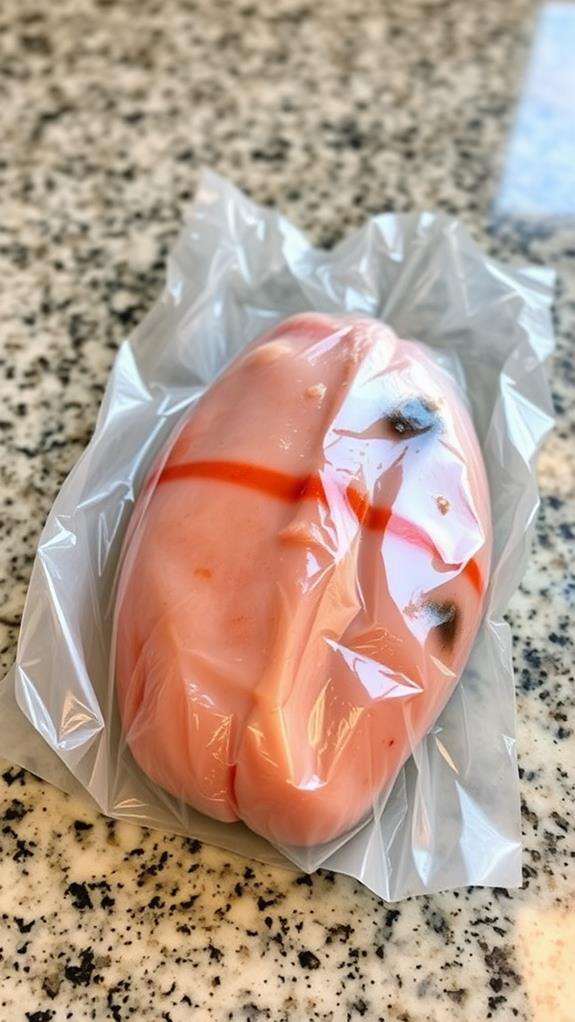
Despite the benefits of vacuum sealing, many people make critical storage mistakes that compromise their food's longevity. If you're vacuum sealing food, you'll want to avoid these common pitfalls that can lead to premature spoilage and waste.
One of the biggest mistakes you're likely making is storing vacuum-sealed bags in areas with temperature fluctuations. Even if you've created a perfect seal, placing bags near your stove or in direct sunlight can cause condensation, which promotes bacterial growth. You're also probably forgetting to label your packages with contents and dates, making it impossible to track shelf life accurately.
Another error you might be making is overfilling bags, which can strain seals and create weak points. When you're storing irregularly shaped items, you should cushion them with paper towels to prevent bag punctures. Don't make the mistake of reusing bags that previously held raw meat, as cross-contamination risks remain even after washing. Additionally, if you're storing foods with sharp edges, like pasta or crackers, you're asking for trouble by not double-bagging or using specialty bags designed for these items.
Extended Pantry Storage Tips
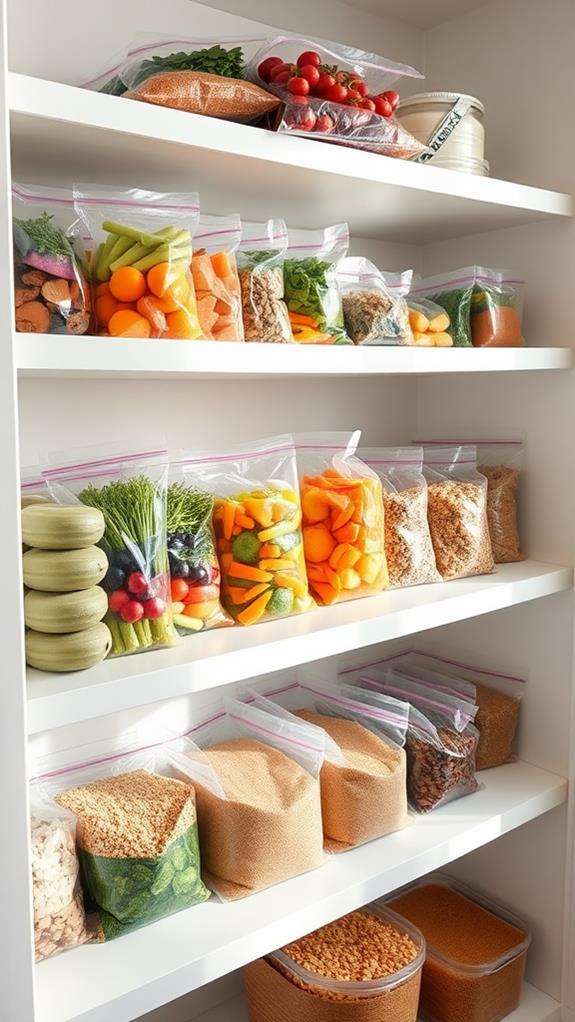
Proper pantry organization can triple the effectiveness of your vacuum sealing efforts. When you're storing vacuum-sealed items in your pantry, you'll need to implement a systematic approach that maximizes both space and preservation potential. Consider creating designated zones for different food categories, and always maintain consistent temperature and humidity levels between 50-70°F and 15% relative humidity.
To enhance your pantry storage for vacuum-sealed items, you'll want to follow these essential guidelines:
- Install adjustable shelving units to accommodate various package sizes and create a modular storage system that grows with your needs
- Implement a first-in-first-out (FIFO) rotation system by labeling each package with both packaging and expiration dates
- Use moisture-absorbing silica gel packets in your pantry to maintain ideal humidity levels around vacuum-sealed items
- Keep a detailed inventory log, either digital or physical, to track storage locations and expiration dates
You'll find that combining these storage practices with proper vacuum sealing techniques considerably extends your food's shelf life. Remember to check your stored items monthly for any signs of seal failure or package damage, and always store vacuum-sealed foods away from direct sunlight and heat sources.
Frequently Asked Questions
Can Vacuum-Sealed Bags Be Reused for Storing Different Foods?
While you might think vacuum-sealed bags are one-and-done items, you can actually reuse them with proper care. You'll need to thoroughly wash the bags with hot, soapy water and guarantee they're completely dry before reusing. However, don't reuse bags that previously stored raw meat, fish, or greasy foods due to contamination risks. For best results, you can designate specific bags for similar food types, like one set for dry goods and another for produce.
Does Vacuum Sealing Eliminate the Need for Food Preservatives Completely?
No, vacuum sealing doesn't completely eliminate the need for preservatives. While it's an effective method to extend shelf life by removing oxygen that bacteria need to grow, you'll still need preservatives for certain foods. You're dealing with various spoilage factors beyond just oxygen, including enzymes, moisture content, and temperature. Think of vacuum sealing as one layer of protection that works alongside other preservation methods, not a complete replacement for preservatives.
How Do Power Outages Affect Vacuum-Sealed Foods in Freezers?
Like Titanic's frozen passengers, your vacuum-sealed foods face their own survival challenge during power outages. You'll want to keep that freezer door shut tight, as each opening lets precious cold air escape. Your vacuum-sealed items will stay safe for about 48 hours in a full freezer, but only 24 hours in a half-full one. Once thawed, you can't refreeze most items – they'll need to be used promptly.
Can Vacuum-Sealed Bags Be Safely Used in Boiling Water?
Yes, you can safely use vacuum-sealed bags in boiling water through a cooking method called sous vide. You'll need to confirm you're using bags specifically designed for high-temperature cooking, as standard storage bags might melt. Don't use regular ziplock bags, as they're not made for boiling. When using proper sous vide bags, you can safely cook your food at temperatures up to 212°F (100°C) without the bag breaking down.
Why Do Some Vacuum-Sealed Bags Lose Their Seal Over Time?
Your vacuum-sealed bags might lose their seal due to several factors. Temperature fluctuations can cause the plastic to expand and contract, weakening the seal over time. Sharp edges on stored items can create tiny punctures, while oils and fats can gradually break down the sealing material. You'll also find that poor initial sealing technique, manufacturing defects, or repeated handling of the bags can compromise the airtight barrier they're designed to maintain.





